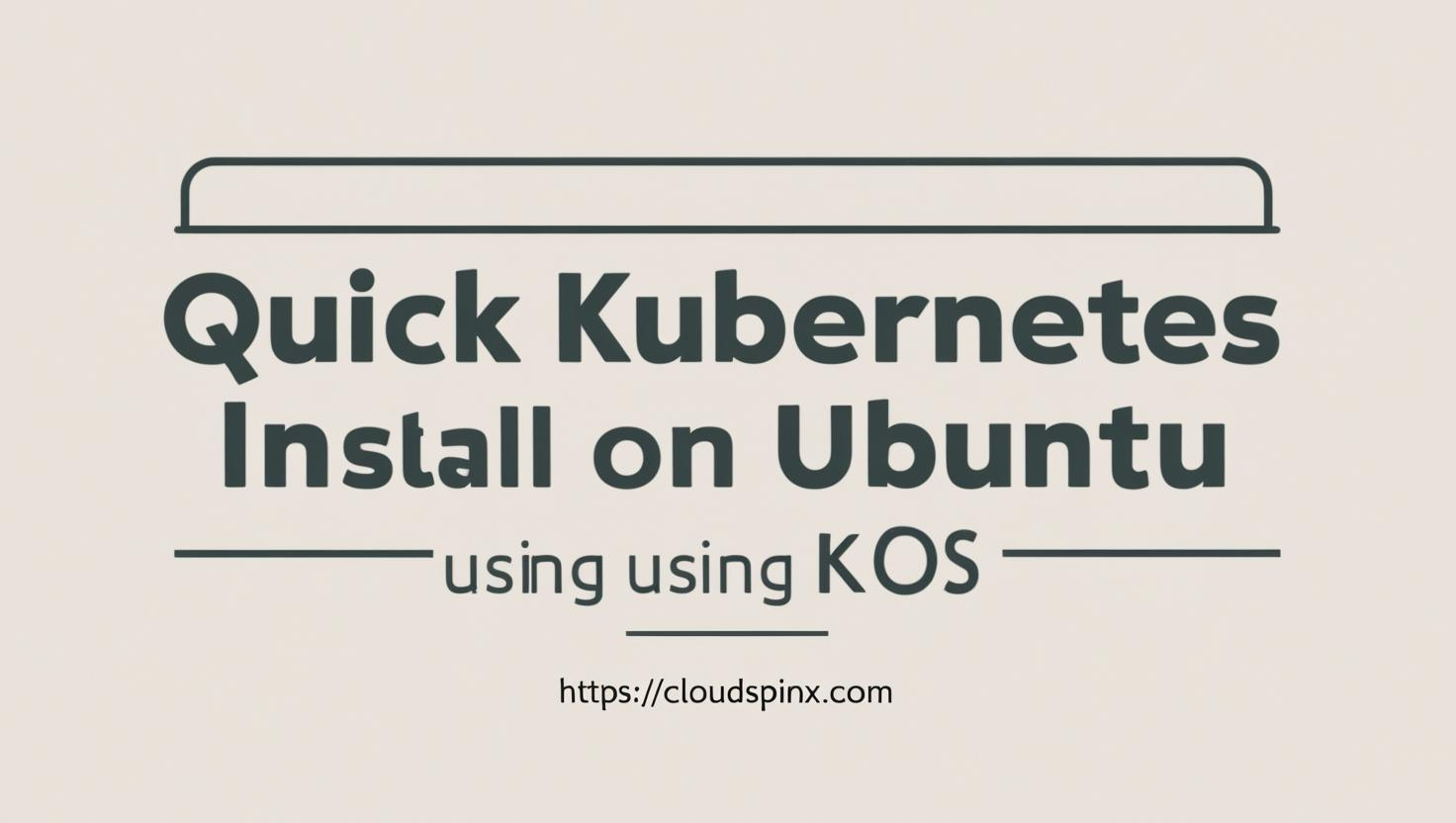


Josphat Mutai
Jul 12, 2025
Quick Kubernetes Install on Ubuntu using k0s
k0s (pronounced "K-zero-ess"), is a lightweight kubernetes distribution created by Mirantis team as the perfect deployment option for edge computing and IoT use cases. It enables you to install and run kubernetes cluster in low low resource infrastructure such as Raspberry Pi hardware. k0s is certified 100% upstream Kubernetes.
In this blog post we shall perform the installation of k0s kubernetes cluster on two Ubuntu Linux machines. One will function as control plane node, and the other node as worker node. But for normal use cases you can use both to run containerized workloads.
Install Kubernetes on Ubuntu using k0s
Ensure your Ubuntu Linux machines are updated:
sudo apt update
sudo apt upgrade -y
Our installations are based on the following host definitions:
| Hostname | IP Address |
|---|---|
| k0snode01.cloudspinx.com | 192.168.20.38 |
| k0snode02.cloudspinx.com | 192.168.20.39 |
Create Control Plane node
After the update, login to the first Ubuntu machine:
Then perform installation of k0s by running the following command:
curl --proto '=https' --tlsv1.2 -sSf https://get.k0s.sh | sudo sh
The script will download the latest stable version of k0s and make it executable from /usr/local/bin/k0s.
To be able to extend the cluster in future to support multi-node setup, you can omit --single flag which basically disable features needed for multi-node clusters:
sudo k0s install controller --enable-worker --no-taints
If you don't want this node to run application container, you can remove --enable-worker --no-taints
After the execution, start the k0s service and enable it to automatically start on system reboot by running the following commands:
sudo k0s start
Check k0s status by running:
$ sudo k0s status
Version: v1.32.2+k0s.0
Process ID: 2489
Role: controller
Workloads: true
SingleNode: false
Kube-api probing successful: true
Kube-api probing last error:
Now that cluster looks healthy, you can manage it using kubectl command:
$ sudo k0s kubectl get nodes
NAME STATUS ROLES AGE VERSION
k0snode01.cloudspinx.com Ready control-plane 3m20s v1.32.2+k0s
Adding Worker nodes
After the control plane node is activated, additional worker nodes can be added. For this, a join token required for joining workers to the cluster. The token embeds information that enables mutual trust between the worker and controller(s) and which allows the node to join the cluster as worker.
The token can be obtained by running the following command on the controller nodes:
sudo k0s token create --role=worker
You will get output similar to:
H4sIAAAAAAAC/2xV3Y7iPBa876fgBWY+J5DWB9JeTMAGAjFjx8cG34U4Q2g7iTsJv6t991Uzs9KutHcnp46qIqtUlfuzLLv+3Daz0TV4K9ylH8qun719G/2ZZ2+j0WhUlN1w/nUu8qH8ll+Gqu3Ow+ObyYd8NtpmaNhmwZyDScQ5XnCZQAY6YYgAf2FomNsgyYDHHNMFU9JrRMYZJLFGTh5qutc2adRyaFIVfOaB3+oa3eUi0WrvH2ALZBDnCvz2GPgkX+kPYQnncNswR2KDDObSUObIigkiOZCJgKhKA+2VqzZG+gPU949SkE8leaxBj9OV20lM3oXkpMRTYIJQjpOKN8WtPPnfGPDuvzEBSVNi/cmknGsUKWYJlZjvzYLoo9TRoQ5USvxB7LlOrRzr0JAcgjjFZgFjspo7mhw+KAaQcyaJZIBRBgk2iLxuM0SuX28CwCu+StwxNDkAfR5RBAxVeyOIZfukE0A/eU3UMfBNropNaaMdtVHFnmQjPuiFjddhYe/vLPR9vud5AfdtoeQaBJsUKAoVcTZfkfaApu8FSs4lqSJl1+EWDeccD6ui0S4/+TB9apfiu0sXlTjCPQKUrDPJtwyGWyZOoV7egpRUvZJ0YZwfNJJXtV/fhHTb44J4gSyiC3IXy2EhHcfmPNznH0l1HPNnutI0HfOucD86HZJAOfkJyHuh3MR88FsBgRKWtmmQJPrcj/VjWB5tey0x+VSrosuwg+JJRRHS0Cy/fOAuecOe/ClbABdRMJGpq9QAr9NA8kxwsglpJB/T2w5TkjYcw3K63+1dzpdkK2qeMJmsC1RFJnD1Ed3G5ocfq5rjwsn9jvhar9xC1uTdAEwKXKUijKqjqHq993PVJM+diBfiMb2mIbqlUndyIfODJEumDGWWxDz0PLdJPLdBTLGJUyktXxnCztMxgIwNcnNW+xhw0gin12CDOVOHCYcEGPAY4HQVsL5xhO9ScawDsmc2gSzgXtfrDZf2TqHiQvHtAWicPeXZOHkxy0MkMdmx2nSFqrocisg84y8PPrklsUA0/tLXq1hk8vQU5ykpkNvmSz/JTj6ggQsOim6ZS36mMFiK6SAkvacr2vAw4FzG4U4ZTsFv0tXhke0Tn4eEQG1WO2GeouafBpFVsVxPeDbtc5nc5i7Z6do05Z6hozVa7hkCVPEdRoEC09IGHtSS2mD+hBW55eTHo2ioZs6PNbI3vfc7WPYoG/MzAHlSJydFYze6vl+O4B0ovS6WemeAtAqmP8XTtAfUPoyd3o0120PdolL5OUenscEDz5+nsURGlJJeYOXDHOQScNTJBWWHk99l4b2HveQGU2uaNijxMDniKuLNeiIhmh+ErA3hFnCSs3EaMeRvhlBtrAlBkHmpqN4RsubWXk0YnFVj2Nzia7Z0bV4bmy6SQahTwM/9lT31BMKgLpriWjR0DuLL41pxJWmGoONLXvMP0vFs8MfAbeVj2IrQOe2qTkvYmIXuaX2Pfwq0+ZPNRFh2YkhmErtlBjSWGF65vGXtP14B35fdtexmo2oYfD/7669gGn4P3v/+HqLv479n75PJ+G00avK6nI0s6t+KthnK+/C7KH7Pf4riT2u8rr4Wl/71dTmWrhy+Hdt26Icu9//Ldum6shm+/YfptbTnxsxG87b5dT69+a78VXZlU5T9bPTPf719sb7E/5D8H/qX8OsXhtaWzWwURH37GXy39aX6eBSTSXcZwtL6t38HAAD//97pMR0EBwAA
Login to the worker node:
Install k0s
curl --proto '=https' --tlsv1.2 -sSf https://get.k0s.sh | sudo sh
Save token to file:
nano workr-join-token.txt
Then use the token printed to join it to the cluster.
sudo k0s install worker --token-file ./workr-join-token.txt
Start k0s on worker node(s):
sudo k0s status
Check status:
$ sudo k0s status
Version: v1.32.2+k0s.0
Process ID: 2522
Role: worker
Workloads: true
SingleNode: false
Kube-api probing successful: true
Kube-api probing last error:
On the controller node, list nodes in the cluster:
$ sudo k0s kubectl get nodes
NAME STATUS ROLES AGE VERSION
k0snode01.cloudspinx.com Ready control-plane 20m v1.32.2+k0s
k0snode02.cloudspinx.com Ready <none> 4m4s v1.32.2+k0s
From the output, we can confirm the cluster has the two nodes as expected.
Display / write kubeconfig
If you want to display cluster admin's kubeconfig file, run:
sudo k0s kubeconfig admin
To make this the default kubeconfig, write the contents to the ~/.kube/config file.
mkdir ~/.kube
sudo k0s kubeconfig admin > ~/.kube/config
If doing this on a workstation and not controller node, copy the output of k0s kubeconfig admin and save it to ~/.kube/config
Install kubectl and run test deployment
Finally, install kubectl:
-
Linux
curl -LO "https://dl.k8s.io/release/$(curl -L -s https://dl.k8s.io/release/stable.txt)/bin/linux/amd64/kubectl" sudo install -o root -g root -m 0755 kubectl /usr/local/bin/kubectl -
macOS (Intel)
curl -LO "https://dl.k8s.io/release/$(curl -L -s https://dl.k8s.io/release/stable.txt)/bin/darwin/amd64/kubectl" chmod +x ./kubectl sudo mv ./kubectl /usr/local/bin/kubectl sudo chown root: /usr/local/bin/kubectl -
macOS (Apple Silicon)
curl -LO "https://dl.k8s.io/release/$(curl -L -s https://dl.k8s.io/release/stable.txt)/bin/darwin/arm64/kubectl" chmod +x ./kubectl sudo mv ./kubectl /usr/local/bin/kubectl sudo chown root: /usr/local/bin/kubectlTest to ensure the version you installed is up-to-date:
kubectl version --clientSample output:
Client Version: v1.32.2 Kustomize Version: v5.5.0We can use kubectl to list all pods in the cluster:
kubectl get pods -A NAMESPACE NAME READY STATUS RESTARTS AGE kube-system coredns-7d4f7fbd5c-7fm2z 1/1 Running 0 21m kube-system coredns-7d4f7fbd5c-f68qs 1/1 Running 0 21m kube-system konnectivity-agent-5x2b6 1/1 Running 0 38m kube-system konnectivity-agent-mj4xn 1/1 Running 0 21m kube-system kube-proxy-h8npl 1/1 Running 0 21m kube-system kube-proxy-z9km9 1/1 Running 0 38m kube-system kube-router-5p2td 1/1 Running 0 21m kube-system kube-router-gmxrd 1/1 Running 0 38m kube-system metrics-server-7778865875-srpxv 1/1 Running 0 38mCreate
hello-world-deploy.yamlfile to confirm you can run new applications in the cluster.
apiVersion: apps/v1
kind: Deployment
metadata:
name: hello-world
spec:
replicas: 2
selector:
matchLabels:
app: hello-world
template:
metadata:
labels:
app: hello-world
spec:
containers:
- name: hello-world
image: nginxdemos/hello
ports:
- containerPort: 80
---
apiVersion: v1
kind: Service
metadata:
name: hello-world-service
spec:
selector:
app: hello-world
ports:
- protocol: TCP
port: 80
targetPort: 80
type: NodePort
Create resources:
kubectl apply -f hello-world-deploy.yaml
Expected output:
deployment.apps/hello-world created
service/hello-world-service created
List all objects created in the current namespace:
kubectl get all
Sample output:
NAME READY STATUS RESTARTS AGE
pod/hello-world-7b5dbb9789-b55q6 1/1 Running 0 71s
pod/hello-world-7b5dbb9789-n62q9 1/1 Running 0 71s
NAME TYPE CLUSTER-IP EXTERNAL-IP PORT(S) AGE
service/hello-world-service NodePort 10.104.156.177 <none> 80:30944/TCP 71s
service/kubernetes ClusterIP 10.96.0.1 <none> 443/TCP 44m
NAME READY UP-TO-DATE AVAILABLE AGE
deployment.apps/hello-world 2/2 2 2 71s
NAME DESIRED CURRENT READY AGE
replicaset.apps/hello-world-7b5dbb9789 2 2 2 71s
Open your browser and access http://nodeip:30944

Uninstall k0s
Follow the following steps to removal of k0s.
- Stop k0s service
sudo k0s stop
Once the service is stopped, run the reset command:
sudo k0s reset
The k0s reset command will perform the clean up of containers, data directories, mounts and network namespaces.
Reboot the system.
sudo reboot
After a reboot, k0s can be reinstalled if desired.
Latest Post
Latest Tags
Categories
Learning Materials
Cloud Services
Cloud Automation
Deployment & Migration
Cloud Support
Microservices & GitOps
Kubernetes & OpenShift
IaC
GitOps
Infra Services
On-prem Infra Services
Emergency Support
Monitoring, Logging & Observability





